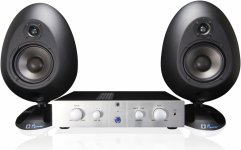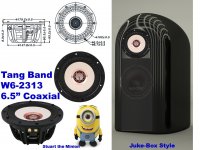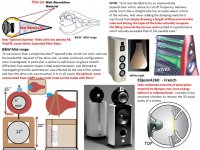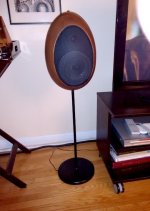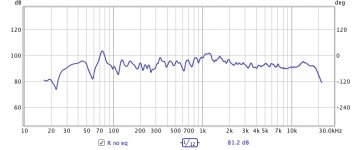Hello!
Anyone has built the Tom Perazella Egg Speakers. I wonder how the result. What type of crossover would you suggest?? Digital XO or passive XO??
A Bold Speaker Project by Tom Perazella | audioXpress
Thanks!
Anyone has built the Tom Perazella Egg Speakers. I wonder how the result. What type of crossover would you suggest?? Digital XO or passive XO??
A Bold Speaker Project by Tom Perazella | audioXpress
Thanks!
That was one strange looking speaker. it reminds of a belgium manufacturer, vaessen. i think it would look better and perform better without the egg on top and only use the pyramid, much like fm acoustics
I wonder why the article didn't mention the Focal design which is 30 years old, I guess.
Focal Egg Project | Parts Express Project Gallery
ONKEN FOCAL - VintageAudio
Focal Egg Project | Parts Express Project Gallery
ONKEN FOCAL - VintageAudio
Also similar to the Speaker Design Works "Exclamation" which used Dayton Audio drivers - Exclamations
That was one strange looking speaker. it reminds of a belgium manufacturer, vaessen. i think it would look better and perform better without the egg on top and only use the pyramid, much like fm acoustics
How tall do you think the triangle section? 17" or taller than that??
One of my friend has given an idea by using a consumer subwoofer crossover at 200hz and only build the egg portion, it will free fro any type of vibration from the bass cabinet, and has a better speaker stand to hold the egg module.
TBI Emperor can crossover at 200Hz with low distortion.
TBI Emperor can crossover at 200Hz with low distortion.
Attachments
One of my friend has given an idea by using a consumer subwoofer crossover at 200hz and only build the egg portion, it will free fro any type of vibration from the bass cabinet, and has a better speaker stand to hold the egg module.
TBI Emperor can crossover at 200Hz with low distortion.
The new BK Doubke Gem may be a good basis to start if you want an OEM sub cabinet and just add the egg.
Double Gem
So, I`ve read the article once again, this time more thoroughly, and yes, even Thomas Perazella said that his concept is based on the Mach 17, so, silly me

But still a very interesting project, with best of both worlds, pyramid for the bass and (almost) a sphere (ok, an egg) for the rest, and probably better chassis as the original.


But still a very interesting project, with best of both worlds, pyramid for the bass and (almost) a sphere (ok, an egg) for the rest, and probably better chassis as the original.
I do not mean to crack your EGG ... 🙂
For on desk placement, a "juke-box" shape is both attractive and has very low edge diffraction distortion.
For in-room placement, the genius engineers at B&W proved that a sphere + rear tapered tube generates exceptional sonic performance. Your anti-vibration shock-mount idea can be used. Bamboo bowls from Ikea have been successfully used for a sturdy low cost sphere ... you can always make molds for concrete later ...🙂
Everything depends upon:
--your ears
--your goals
--your room
--your budget
--your woodshop
For on desk placement, a "juke-box" shape is both attractive and has very low edge diffraction distortion.
For in-room placement, the genius engineers at B&W proved that a sphere + rear tapered tube generates exceptional sonic performance. Your anti-vibration shock-mount idea can be used. Bamboo bowls from Ikea have been successfully used for a sturdy low cost sphere ... you can always make molds for concrete later ...🙂
Everything depends upon:
--your ears
--your goals
--your room
--your budget
--your woodshop
Attachments
I'd like to clear up some questions you have about the egg speakers I built. First, any speaker project has limitations and compromises must be made. The project will be successful if the compromises maximize the things you like. With the eggs I made the compromises that would result in the outcome I wanted. As far as the height of the pyramid bass cabinets, they are just under 40". The tops are tapered to a round section that matches the bottom of the eggs further reducing any diffraction as the wave front travels down to the pyramid.
The egg shape has advantages over the continuation of the pyramid shape to include the mid and tweeter. This was discussed at length in the September 2018 issue of audioXpress, the first of the three issues plus web info that covered the project. Especially important are the references to the works of Olson and Beranek on diffraction. That issue also discussed other egg shaped speakers that are available. Going into more detail on those was not possible as the article already spanned 3 issues. I used to spend a lot of time with Dick Sequerra when he was still in NY and auditioned his original Metronome speakers and was very impressed. My personal opinion is that the egg shape does a better job than the pyramid shape on the top where the wavelengths get shorter and diffraction from edges becomes critical.
As far as separating the egg from the bass cabinet, with that cabinet handling frequencies up to 200 Hz the problem of localization becomes a problem. I try to avoid going over 80 Hz in a separate sub to minimize problems of image shift which are noticeable over 80 Hz. Also, the two 12" Dayton drivers provide enough linear volume displacement that high levels of low bass are possible with low distortion. For more on that please refer to the April and May issues of audioXpress that contain my article "true Bass Rides Again".
As far as passive or active, the crossovers I built allow both. I am a fan of active but I use the passive with great results when the eggs are used to test ampifiers full range. When active I use a DEQX Express II to provide all DSP functions including crossovers, filters, and time alignment. It has proven to be an outstanding device when used with several of my speaker projects. Hope this helps.
Tom
The egg shape has advantages over the continuation of the pyramid shape to include the mid and tweeter. This was discussed at length in the September 2018 issue of audioXpress, the first of the three issues plus web info that covered the project. Especially important are the references to the works of Olson and Beranek on diffraction. That issue also discussed other egg shaped speakers that are available. Going into more detail on those was not possible as the article already spanned 3 issues. I used to spend a lot of time with Dick Sequerra when he was still in NY and auditioned his original Metronome speakers and was very impressed. My personal opinion is that the egg shape does a better job than the pyramid shape on the top where the wavelengths get shorter and diffraction from edges becomes critical.
As far as separating the egg from the bass cabinet, with that cabinet handling frequencies up to 200 Hz the problem of localization becomes a problem. I try to avoid going over 80 Hz in a separate sub to minimize problems of image shift which are noticeable over 80 Hz. Also, the two 12" Dayton drivers provide enough linear volume displacement that high levels of low bass are possible with low distortion. For more on that please refer to the April and May issues of audioXpress that contain my article "true Bass Rides Again".
As far as passive or active, the crossovers I built allow both. I am a fan of active but I use the passive with great results when the eggs are used to test ampifiers full range. When active I use a DEQX Express II to provide all DSP functions including crossovers, filters, and time alignment. It has proven to be an outstanding device when used with several of my speaker projects. Hope this helps.
Tom
Is 100W capable to drive this Egg speakers??
Since the overall sensitivity is around 90 dB at 2.83 volts, a 100 watt amplifier with benign overload characteristics should work fine.
This egg was designed by Paul Young around 1980 for the Dayton-Wright division of Leigh Instruments. Crossover very complicated like LS3/5A and has choice of jacks for near to wall versus far to wall. Hangs, stands, rolls, leans, from top or from bottom, all kinds of mounting came with it. I like the little stands, in the picture. Leigh came to a bad end so it never was put into full production. I own two sets.
I can't say much about the REW trace except 1:12, no EQ, prolly far-field, and seems quite spectacularly good for a little two-way speaker.
B.
I can't say much about the REW trace except 1:12, no EQ, prolly far-field, and seems quite spectacularly good for a little two-way speaker.
B.
Attachments
Last edited:
- Status
- Not open for further replies.
- Home
- Loudspeakers
- Multi-Way
- Egg Speakers by Tom Perazella
